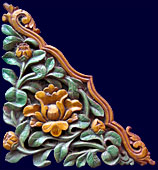|
|
A brief history of Chinese Astronomy at the Beijing Ancient Observatory - 北京古观象台 |
|
|
|
|
Decorative Details at the Forbidden City - Ceramics, granite relief, beams, and rooftops - 故宫博物院 |
|
|
|
|
Funeral Objects from the Han to the Northern and Southern Dynasties at the Palace Museum, Forbidden City - 故宫博物院 |
|
|
|
|
Beijing's Tian'anmen Square 天安门广场 has been a center of Chinese history and government since the Ming Dynasty. The old buildings were razed to make room for the Great Hall of the People, the National Museum, Monument to the People's Heroes, and Mao Zedong's Mausoleum. On the southern end, the Archery Tower and Zhengyang Gate are vestiges of the old fortifications.
|
|
|
|
|
The Forbidden City was built by the Yongle Emperor between 1406 and 1421. The politics that motivated his decision to move to Beijing from Nanjing motivated his desire to build a palace and city that linked the Ming Dynasty to the traditions of the Tang and Han Dynasties of the past.. The Palace Museum 故宫博物院 presents visitors with a glimpse of history, culture, art, and traditions that linked the dynasties through the ages. |
|
|
|
|
The City Walls of Beijing were built at the same time as the Forbidden City, between 1416 and 1421. Additional fortifications in the form of arrow gates were added in the 1430s. The city was expanded by enclosing the southern section of the city in 1550 after an aborted attempt by Mongol raiders to enter Beijing. Beginning in 1915, the gates and walls of the city were demolished for various construction projects. Pictures from the late 1800s and early 1900s record give us a record of the lost gates. |
|
|
|
|
Babaoshan 八宝山 is the Revolutionary Cemetery to the west of Beijing. On the first day of Qing Ming Festival 清明节 Babaoshan was ablaze with color. Qingming is the season to remember the dead, similar to our Memorial Day, but the tradition dates back to 900 AD. The tombs in Babaoshan are a record of recent Chinese history. Revolutionary poets such as Wen Yiduo 闻一多 and Emi Siao 萧三 and entertainers such as Hou Baolin 侯宝林 are buried there. Members of the Long March such as Yu Qiuli 余秋里, General Zhou Chunquan 周纯全, and Deng Liujin 邓六金 are honored at Babaoshan. |
|
|
|
|
Beijing Underground City 北京地下城 was a set of tunnels connecting major points of Beijing and designed as an air-raid shelter. It was built between 1969 and 1979 and fortunately was never used for its designated purpose. Includes a brief history to the breakdown of Sino-Soviet relations in the 1960s and an essay by 冯世则 Feng Shize. |
|
|
|
|
Qianmen Before the Olympics in 2008, the first stage of a reconstruction of areas south of Tian'anmen was opened to the public. Photographs from the early 1900s, 2004, 2005, and 2008 will take you on a trip through history. The modernization of Dashila hutong 大栅栏胡同, Qianmen Dajie 前门大街, Dashila Jie 大栅栏街, and nearby areas gives a picture of both loss and gain as Beijing searches for a new face. |
|
|
|
|
Baiyun Guan - White Cloud Temple 白云观 is a Daoist Temple built in 739 during the Tang Dynasty. One of the founders of Quanzhen Daoism, Qiu Chuji 丘处机 (Qiu Changchun 丘长春), took a journey to western countries to meet with Genghis Kahn. Table of Contents on the first page. |
|
|
|
|
The Marco Polo Bridge 卢沟桥 was made famous in Europe when Marco Polo returned to Venice and wrote about it. In the next section, you will see the bridge and learn the history, here you get lions, and more lions, just the lions. |
|
|
|
|
The Lugou Qiao or Marco Polo Bridge 卢沟桥 was built across the Yongding to provide convenient access to the regions west and south of Beijing. The history of Beijing is outlined from the Liao Dynasty. The bridge served the Jin, Yuan, Ming, and Qing Dynasties and served as a lifeline between Beijing and the rest of China when the Japanese surrounded Beijing in the 1930s. |
|
|
|
|
The Jade Collection at Beijing's Capital Museum 首都博物馆
focuses on jade within the context of the history of Beijing by limiting the collection to jades found in and around Beijing dating from Neolithic times to the Qing Dynasty.
|
|
|
|
|
The early history of Beijing is seen in Yan roof tiles dating to the Warring States Period. Neolithic pottery from multiple cultures shows early history of China. |
|
|
|
|
|
|
 |
|